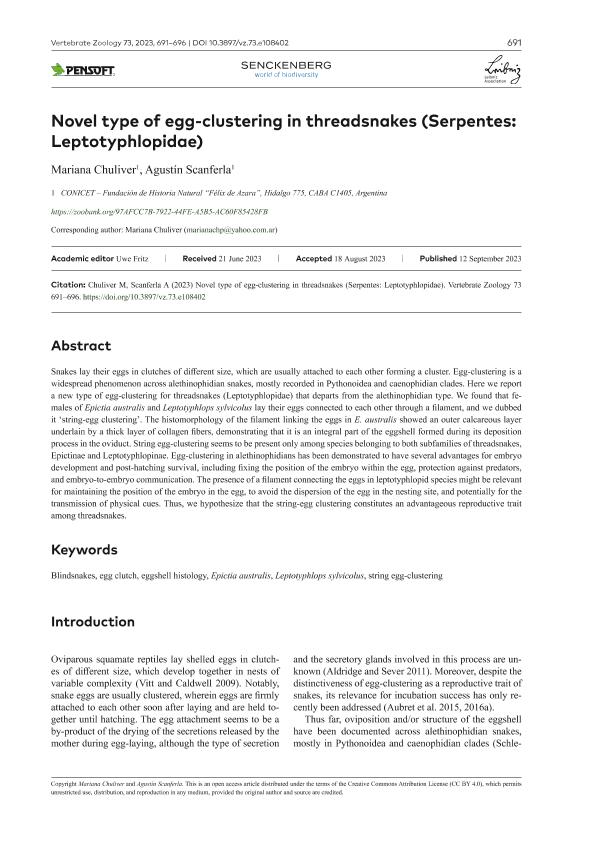Mostrar el registro sencillo del ítem
dc.contributor.author
Chuliver Pereyra, Mariana

dc.contributor.author
Scanferla, Carlos Agustín

dc.date.available
2023-12-18T18:08:29Z
dc.date.issued
2023-09
dc.identifier.citation
Chuliver Pereyra, Mariana; Scanferla, Carlos Agustín; Novel type of egg-clustering in threadsnakes (Serpentes: Leptotyphlopidae); Senckenberg Gesellschaft für Naturforschung; Vertebrate Zoology; 73; 9-2023; 691-696
dc.identifier.issn
1864-5755
dc.identifier.uri
http://hdl.handle.net/11336/220674
dc.description.abstract
Snakes lay their eggs in clutches of different size, which are usually attached to each other forming a cluster. Egg-clustering is a widespread phenomenon across alethinophidian snakes, mostly recorded in Pythonoidea and caenophidian clades. Here we report a new type of egg-clustering for threadsnakes (Leptotyphlopidae) that departs from the alethinophidian type. We found that females of Epictia australis and Leptotyphlops sylvicolus lay their eggs connected to each other through a filament, and we dubbed it ‘string-egg clustering’. The histomorphology of the filament linking the eggs in E. australis showed an outer calcareous layer underlain by a thick layer of collagen fibers, demonstrating that it is an integral part of the eggshell formed during its deposition process in the oviduct. String egg-clustering seems to be present only among species belonging to both subfamilies of threadsnakes, Epictinae and Leptotyphlopinae. Egg-clustering in alethinophidians has been demonstrated to have several advantages for embryo development and post-hatching survival, including fixing the position of the embryo within the egg, protection against predators, and embryo-to-embryo communication. The presence of a filament connecting the eggs in leptotyphlopid species might be relevant for maintaining the position of the embryo in the egg, to avoid the dispersion of the egg in the nesting site, and potentially for the transmission of physical cues. Thus, we hypothesize that the string-egg clustering constitutes an advantageous reproductive trait among threadsnakes.
dc.format
application/pdf
dc.language.iso
eng
dc.publisher
Senckenberg Gesellschaft für Naturforschung
dc.rights
info:eu-repo/semantics/openAccess
dc.rights.uri
https://creativecommons.org/licenses/by-nc-sa/2.5/ar/
dc.subject
BLINDSNAKES
dc.subject
EGG CLUTCH
dc.subject
EGGSHELL HISTOLOGY
dc.subject
EPICTIA AUSTRALIS
dc.subject
LEPTOTYPHLOPS SYLVICOLUS
dc.subject
STRING EGG-CLUSTERING
dc.subject.classification
Zoología, Ornitología, Entomología, Etología

dc.subject.classification
Ciencias Biológicas

dc.subject.classification
CIENCIAS NATURALES Y EXACTAS

dc.subject.classification
Biología Reproductiva

dc.subject.classification
Ciencias Biológicas

dc.subject.classification
CIENCIAS NATURALES Y EXACTAS

dc.title
Novel type of egg-clustering in threadsnakes (Serpentes: Leptotyphlopidae)
dc.type
info:eu-repo/semantics/article
dc.type
info:ar-repo/semantics/artículo
dc.type
info:eu-repo/semantics/publishedVersion
dc.date.updated
2023-12-15T14:03:31Z
dc.identifier.eissn
2625-8498
dc.journal.volume
73
dc.journal.pagination
691-696
dc.journal.pais
Alemania

dc.journal.ciudad
Dresden
dc.description.fil
Fil: Chuliver Pereyra, Mariana. Consejo Nacional de Investigaciones Científicas y Técnicas; Argentina. Fundación de Historia Natural Félix de Azara; Argentina
dc.description.fil
Fil: Scanferla, Carlos Agustín. Fundación de Historia Natural Félix de Azara; Argentina. Consejo Nacional de Investigaciones Científicas y Técnicas; Argentina
dc.journal.title
Vertebrate Zoology
dc.relation.alternativeid
info:eu-repo/semantics/altIdentifier/url/https://vertebrate-zoology.arphahub.com/article/108402/
dc.relation.alternativeid
info:eu-repo/semantics/altIdentifier/doi/http://dx.doi.org/10.3897/vz.73.e108402
Archivos asociados
